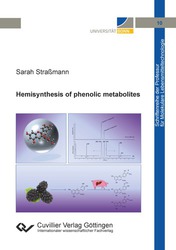| Areas | |
|---|---|
| Serie de libros (96) |
1377
|
| Nachhaltigkeit |
3
|
| Gesundheitswesen |
1
|
| Letra |
2361
|
| Ciencias Naturales |
5403
|
| Matemática | 229 |
| Informática | 318 |
| Física | 979 |
| Química | 1362 |
| Geociencias | 131 |
| Medicina humana | 243 |
| Estomatología | 10 |
| Veterinaria | 108 |
| Farmacia | 147 |
| Biología | 835 |
| Bioquímica, biología molecular, tecnología genética | 121 |
| Biofísica | 25 |
| Nutrición | 45 |
| Agricultura | 1004 |
| Silvicultura | 201 |
| Horticultura | 20 |
| Ecología y conservación de la tierra | 148 |
| Ciencias Ingeniería |
1788
|
| General |
97
|
|
Leitlinien Unfallchirurgie
5. Auflage bestellen |
|
Erweiterte Suche
Hemisynthesis of phenolic metabolites (Volumen 10) (Tienda española)
Sarah Straßmann (Autor)Previo
Lectura de prueba, PDF (920 KB)
Indice, PDF (700 KB)
Polyphenols are considered healthy because they are supposed to protect people from civilization diseases such as cardiovascular diseases, cancer, or diabetes. This may be due to the inhibition of inflammation or their antioxidant effects. However, there is still a lot of research to be done in this direction because their absorption, distribution, metabolism, and excretion depend on many factors. Moreover, it is possible that the metabolites have a different bioactivity than the original substances. Therefore, it is necessary to accurately identify and quantify the anthocyanin metabolites, and for that reference substances are urgently needed. Because they are not commercially available and cannot be isolated from plants or physiological samples their synthesis is indispensable. Their synthesis can be achieved in different ways: the most obvious realized in this work are enzymatic or chemical approaches. To analyze the results in an advanced way, ion mobility mass spectrometry coupled to a qToF was used. From the obtained data it is possible to establish a database, which may be used to identify metabolites in real biological samples. This is a benefit for the untargeted metabolomics and allows further elucidation of the metabolism of anthocyanins and thus the health-promoting effect of anthocyanins.
| ISBN-13 (Impresion) | 9783736975255 |
| ISBN-13 (E-Book) | 9783736965256 |
| Formato | A5 |
| Idioma | Inglés |
| Numero de paginas | 122 |
| Laminacion de la cubierta | mate |
| Edicion | 1. |
| Serie | Schriftenreihe der Professur für Molekulare Lebensmitteltechnologie |
| Volumen | 10 |
| Lugar de publicacion | Göttingen |
| Lugar de la disertacion | Bonn |
| Fecha de publicacion | 18.11.2021 |
| Clasificacion simple | Tesis doctoral |
| Area |
Química de alimentación
|
| Palabras claves | Chemie, Lebensmittelchemie, Semisynthese, Polyphenole, Flavonoide, Anthocyane, Cyanidin, Cyanidin-3-O-glucosid, Metaboliten, Metabolismus, Phase 2, Methylierung, Sulfatierung, Glucuronidierung, Analytik, Massenspektrometrie, Chromatographie, Referenzsubstanzen, Chemische Synthese, Ionenmobilitätsspektrometrie, Peonidin, Peonidin-3-O-glucosid, Anthocyanidine, LC-MS, CCS, Schweineleberenzyme, Superfruit, Brombeere, Antioxidative Wirkung, Bioverfügbarkeit, Glucuronosyltransferasen, Methyltransferasen, Sulfotransferasen, Enzymatische Synthese, Grüne Chemie, Dimethylcarbonat, Absorption, Identifizierung, Derivatisierung, Stoffwechsel, Chemistry, Food chemistry, Hemisynthesis, polyphenols, flavonoids, anthocyanins, cyanidin, cyanidin-3-O-glucoside, metabolites, metabolism, phase 2, methylation, sulfation, glucuronidation, analysis, mass spectrometry, chromatography, reference substances, chemical synthesis, ion mobility spectrometry, peonidin, peonidin-3-O-glucoside, anthocyanidins, LC-MS, CCS, porcine liver enzymes, superfruit, blackberry, antioxidativity, bioavailability, glucuronosyltranferases, methyltransferases, sulfotransferases, enzymatic synthesis, green chemistry, dimethyl carbonate, absorption, identification, derivatization, metabolism |








